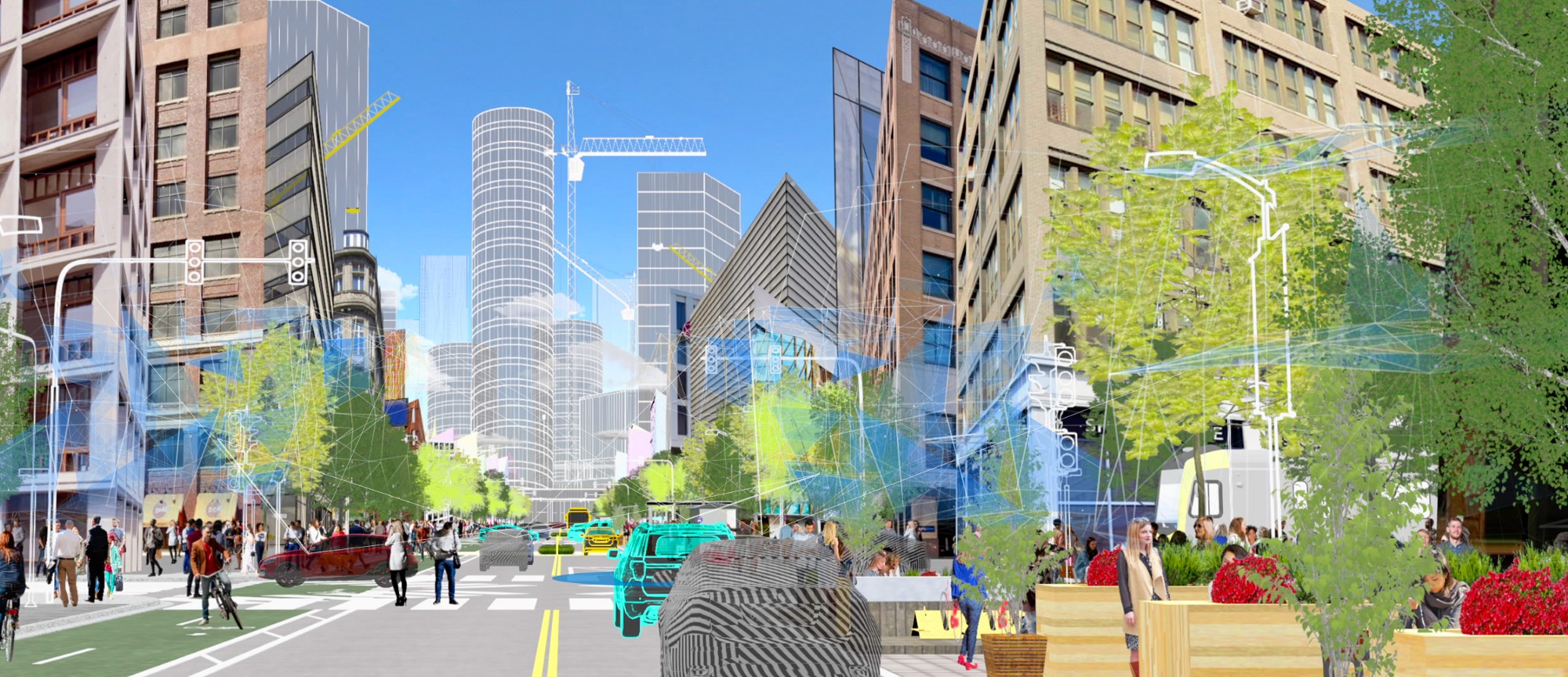Taking Back the Streets: Using Systems Thinking to Return Our City Streets to the Community
By Marcy Klevorn, Ford Executive Vice President and President, Mobility

From subway systems and bus lines to taxi fleets, ride-hailing services and personal vehicles, cities offer lots of ways to get around. This abundance of choice must make life easier, right? Unfortunately, no. And that’s because each mode of transportation has been optimized to work as well as it possibly can on its own, but getting them all to work together hasn’t been at the top of too many to-do lists. It would be, though, if more of us involved in the transportation system were focused on optimizing mobility for the people in our cities versus the technology itself.
Picture, for a moment, a couple in New York City who has purchased a large area rug and now has to figure out how to get it home. Dragging the rug behind them to a subway station or bus stop is impractical. Finding a taxi or ride-hailing service that can accommodate their purchase is unlikely. Even getting the item delivered to their apartment can be a challenge — they may not be able to be at home during the delivery window that inevitably gets extended when traffic prevents the driver from arriving on time. Or the delivery van may be unable to find easy parking on their busy street, leading to double parking that clogs up traffic even more.
Now, what if this couple had the ability to hail a ride that will fit their purchase? Or what if the store’s delivery service was able to assess real-time traffic issues to reach their home at the same time they arrive, having reserved and paid for curbside parking through wireless transactions — all while avoiding any negative impact on other road users and residents?
The way to tackle these challenges is to think of the multiple mobility elements in a city as part of a singular transportation network comprising several layers — the infrastructure, including roads and sidewalks; equipment, such as traffic lights; transportation modes, such as personal vehicles, mass transit and ride-sharing services; and finally, digital interfaces and processes. Individual solutions — electric vehicles, autonomous vehicles, ride-sharing services — can all serve a purpose, but they need to act in the context of this system with all the other components, speaking a common language and working together.

So how do we create this smarter system, one that can offset inevitable increases in demand with intelligence and efficiency? Clearly, we can’t redesign our cities from scratch or make significant investments in new infrastructure that follows the same models. What we need to do is unleash our creativity to provide innovative solutions to our transportation systems that improve them for the good of everyone using our roadways.
At Ford, we’re developing solutions that can help synchronize this cacophony of services and functions to orchestrate a safer, more efficient city environment. Advancing our complex urban transportation systems to this level entails the large-scale connection of various, distinct bits of information. Our cities need a platform that can facilitate the flow of information and perform base processes — such as payment methods or identity verification — to support the entire ecosystem. Working with our partners at Autonomic, we’re developing exactly that with the creation of the Transportation Mobility Cloud — an open, cloud-based platform for mobility services.
With this platform, transportation modes in cities can work together. For example, instead of double parking on an already crowded street, a delivery van could reserve and pay for curbside parking, and the city would be able to tell the next vehicle in line when that same space will be available. With the Transportation Mobility Cloud, residents and businesses could have the information and access necessary to make smarter choices for their schedules, for external factors such as weather, and for their wallets.
Optimizing at this system level requires the components in the transportation ecosystem be able to communicate — to speak the same language. That’s where technology like cellular vehicle-to-everything can play an important role. C-V2X capability, which we’re working to validate with our partners at Qualcomm, enables various technologies and applications in a city — vehicles, stoplights, signs, cyclists and pedestrian devices — to speak to each other and share information.
Ford believes C-V2X will enable our cars and cities of the future to share fast, safe, and secure communications. Sharing mobility data amongst communities can help unclog streets and open up curb space, while communications between vehicles and city infrastructure can help optimize traffic flow. Imagine sitting in a vehicle and having the one in front send an alert about a road hazard that’s forcing it to make a sudden movement, giving your vehicle a chance to adjust its positioning safely. Consider the benefits of having a stoplight along your commute that sends you an alert about stopped traffic, giving you time to reroute and emergency vehicles a clear path to the accident ahead.
The potential of these two initiatives — our open mobility services platform and participation in a robust communications system — will truly come into its own when self-driving vehicles enter the urban transportation system in high volumes and change the way people and goods get around. We aren’t interested in developing self-driving vehicles to operate simply as isolated nodes in a massive transportation environment, because that likely won’t deliver on the potential the technology can bring about. Inside an efficient, connected and optimized transportation system, this technology holds the promise for a whole new approach to moving goods, distributing content and serving humanity.
We can envision the day when a dry cleaner relies on a self-driving delivery vehicle to smartly and efficiently distribute clean clothes to owners around the community, eliminating the congestion from multiple vehicles parking and double parking, and freeing up valuable time for customers. Perhaps those two curbside spots in front of the cleaners have a future as a parklet, providing the neighborhood with valuable greenspace.
With a system optimized across technologies and transit modes, our cities will be better situated to manage the flow of people and goods, and provide opportunities to return the streets to potentially more valuable uses. Cities with highly efficient transportation systems will have shared modes of transportation operating so efficiently that commuters will be confident choosing them, reducing the number of vehicles using our streets. And in a highly efficient transportation system, cities will be able to provide greater access to mobility for chronically underserved citizens who live in transit, food and healthcare deserts.
As we continue along the path of increased connectivity, these developments should grant us the opportunity to realize great benefits for people everywhere. The ability to better orchestrate our mobility ecosystems can ensure traffic reroutes around accidents or other logjams, and can prevent rush hour from being a nightmare. By understanding how our streets are being used, we can determine the safest pick-up and drop-off spots for ride-hailing services, especially as they add self-driving vehicles to their fleets. And by connecting all our transit modes to one system, we can give people the power to access even better route planning services — either before they leave their home or even in the middle of their trip — so they can determine the best way to get where they want to be.
Our streets are where the world lives, works, moves and connects; they are dominant components of public space, generators of urban economies and social activities, and they should serve the people of our cities, not cars. We can create this kind of space again, freeing up our streets and reassessing the values we want them to reflect by re-envisioning how our transportation systems work at every level, and focusing on the people we are serving versus the technology we have built. Together, we can take back our streets.?
